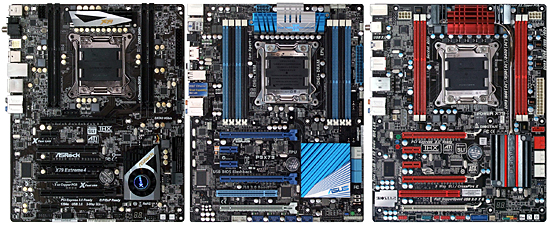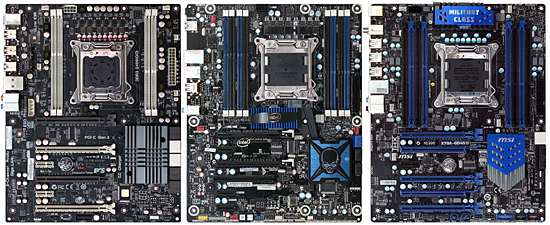Six $200-$260 LGA 2011 Motherboards, Reviewed
We know that Intel's X79 Express platform hosts the fastest desktop processors in the company's portfolio. But can it be made more affordable? We round up the least-expensive $200-$260 motherboards to determine how much you have to give up for cheap X79.
Can LGA 2011 Be Made More Affordable?
Motherboard designers can approach cost-cutting from several different angles. They can selectively lop off certain features or change their layouts, facilitating fewer PCB layers. They can pare back value-added bundles or even offer mail-in rebates that a majority of folks never take the time to redeem. We've seen these approaches work really well on mainstream platforms, and we're sometimes surprised to find exceptional reliability persisting, despite the need to shave off precious dollars and cents. But Intel's LGA 2011 interface is a different animal entirely. Its four memory channels feed a complex processor, which attaches to a more expensive PCH. Together, that all results in a higher starting price for Core i7-3000-compatible motherboards.
And then you have to take the cost of Intel's processors into account. Even the lowest-end Core i7-3820 is expected to sell for close to $300, and that's a quad-core mode. Consequently, we can't expect too many enthusiasts to tolerate a cut-down, incomplete motherboard to complement any Sandy Bridge-E-based chip.
Pricing and quality expectations come to a head in the sub-$260 LGA 2011 market, where some buyers will certainly wonder why an entry-level board still costs $100 more than LGA 1155-based platforms with seemingly similar on-board extras. Quite simply, the costs associated with Sandy Bridge-E are higher, in part because of Intel's prices and also because the boards are more difficult to design.
| X79 Motherboard Features | |||
|---|---|---|---|
| Row 0 - Cell 0 | ASRock X79 Extreme4 | Asus P9X79 | Biostar TPower X79 |
| PCB Revision | 1.03 | 1.01 | 5.0 |
| Chipset | Intel X79 Express | Intel X79 Express | Intel X79 Express |
| Voltage Regulator | Eight Phases | 10 Phases | Six Phases |
| BIOS | P1.70 (02/02/2012) | 0906 (12/22/2011) | X79AE118 (01/18/2012) |
| 100.0 MHz BCLK | 100.0 MHz (+0.00%) | 100.1 MHz (+0.10%) | 100.0 MHz (+0.00%) |
| Internal Interfaces | |||
| PCIe 3.0 x16 | 3 (x16/x16/x8) | 3 (x16/x16/x8) | 3 (x16/x16/x8) |
| PCIe 2.0 x16 | None | None | None |
| PCIe x1/x4 | 2/0 | 2/0 | 2/0 |
| Legacy PCI | 2 | 1 | 1 |
| USB 2.0 | 3 (6-ports) | 4 (8-ports) | 2 (4-ports) |
| USB 3.0 | 1 (2-ports) | None | 1 (2-ports) |
| IEEE-1394 | 1 | None | None |
| Serial Port | 1 | 1 | 1 |
| Parallel Port | None | None | None |
| SATA 6.0 Gb/s | 5 | 2 | 3 |
| SATA 3.0 Gb/s | 4 | 4 | 4 |
| 4-Pin Fan | 2 | 6 | 1 |
| 3-Pin Fan | 4 | None | 2 |
| FP-Audio | 1 | 1 | 1 |
| S/PDIF I/O | Output Only | Output Only | Output Only |
| Power Button | Yes | No | Yes |
| Reset Button | Yes | No | Yes |
| CLR_CMOS Button | No | No | Yes |
| Diagnostics Panel | Numeric | Pass/Fail LED | Numeric |
| I/O Panel Connectors | |||
| P/S 2 | 2 | 1 | 1 |
| USB 3.0 | 2 | 4 | 6 |
| USB 2.0 | 6 | 6 | 2 |
| IEEE-1394 | 1 | 1 | None |
| Network | Single | Single | Single |
| eSATA | 1 | 2 (1-Powered) | 1 (Powered) |
| CLR_CMOS Button | Yes | Yes | No |
| Digital Audio Out | Optical + Coaxial | Optical | Optical + Coaxial |
| Digital Audio In | None | None | None |
| Analog Audio | 6 | 6 | 6 |
| Other Devices | None | None | None |
| Mass Storage Controllers | |||
| Chipset SATA | 2 x SATA 6Gb/s 4 x SATA 3Gb/s | 2 x SATA 6Gb/s 4 x SATA 3Gb/s | 2 x SATA 6Gb/s 4 x SATA 3Gb/s |
| Chipset RAID Modes | 0, 1, 5, 10 | 0, 1, 5, 10 | 0, 1, 5, 10 |
| Add-In SATA | 2 x ASM1061 PCIe3 x SATA 6Gb/s1 x eSATA 6Gb/s | ASM1061 PCIe2 x eSATA 6Gb/s | ASM1061 PCIe1 x SATA 6Gb/s1 x eSATA 6Gb/s |
| USB 3.0 | 2 x ASM1042 PCIe | 2 x ASM1042 PCIe | 4 x ASM1042 PCIe |
| IEEE-1394 | VT6315N PCIe 2 x 400 Mb/s | VT6315N PCIe | None |
| Gigabit Ethernet | |||
| Primary LAN | BCM57781 PCIe | WG82579V PHY | RTL8111E PCIe |
| Secondary LAN | None | None | None |
| Audio | |||
| HD Audio Codec | ALC898 | ALC892 | ALC898 |
| DDL/DTS Connect | Not Specified | DTS Connect | Not Specified |
.
| X79 Motherboard Features | |||
|---|---|---|---|
| Row 0 - Cell 0 | ECS X79R-AX Black Deluxe | Intel DX79TO | MSI X79A- GD45 8D |
| PCB Revision | 1.0 | 1 | 2.0 |
| Chipset | Intel X79 Express | Intel X79 Express | Intel X79 Express |
| Voltage Regulator | Seven Phases | Six Phases | Eight Phases |
| BIOS | 79D1B29A (11/29/2011) | SI0424P (01/27/2012) | V10.2 (01/31/2011) |
| 100.0 MHz BCLK | 100.0 MHz (+0.00%) | 100.0 MHz (+0.00%) | 100.0 MHz (+0.00%) |
| Internal Interfaces | |||
| PCIe 3.0 x16 | 4 (x16/x0/x16/x0 or x8/x8/x8/x8) | 2 (x16/x16) | 3 (x16/x16/x8) |
| PCIe 2.0 x16 | None | None | 2 (x1/x1) |
| PCIe x1/x4 | 2/0 | 3/0 | 1/0 |
| Legacy PCI | None | 1 | None |
| USB 2.0 | 2 (4-ports) | 4 (8-ports) | 2 (4-ports) |
| USB 3.0 | 1 (2-ports) | None | 1 (2-ports) |
| IEEE-1394 | None | 1 | None |
| Serial Port | 1 | None | 1 |
| Parallel Port | None | None | None |
| SATA 6.0 Gb/s | 6 | 2 | 2 |
| SATA 3.0 Gb/s | 4 | 4 | 4 |
| 4-Pin Fan | 2 | 4 | 5 |
| 3-Pin Fan | 3 | None | None |
| FP-Audio | 1 | 1 | 1 |
| S/PDIF I/O | Output Only | None | None |
| Power Button | No | Yes | Yes |
| Reset Button | No | Yes | No |
| CLR_CMOS Button | No | No | No |
| Diagnostics Panel | None | Numeric | None |
| I/O Panel Connectors | |||
| P/S 2 | 1 | None | 2 |
| USB 3.0 | 4 | 2 | 2 |
| USB 2.0 | 6 | 6 | 6 |
| IEEE-1394 | None | 1 | None |
| Network | Single | Single | Single |
| eSATA | None | None | None |
| CLR_CMOS Button | No | Back to BIOS | Yes |
| Digital Audio Out | Optical | None | Optical + Coaxial |
| Digital Audio In | None | None | None |
| Analog Audio | 5 | 3 | 6 |
| Other Devices | None | None | None |
| Mass Storage Controllers | |||
| Chipset SATA | 2 x SATA 6Gb/s 4 x SATA 3Gb/s 4 x SAS 6Gb/s | 2 x SATA 6Gb/s 4 x SATA 3Gb/s | 2 x SATA 6Gb/s 4 x SATA 3Gb/s |
| Chipset RAID Modes | 0, 1, 5, 10 | 0, 1, 5, 10 | 0, 1, 5, 10 |
| Add-In SATA | None | None | None |
| USB 3.0 | TUSB7340 PCIe TUSB7320 PCIe | D720200F1 PCIe | 2 x D720200F1 PCIe |
| IEEE-1394 | None | VT6315N PCIe | None |
| Gigabit Ethernet | |||
| Primary LAN | RTL8111E PCIe | WG82579LM PHY | WG82579V PHY |
| Secondary LAN | None | None | None |
| Audio | |||
| HD Audio Codec | ALC892 | ALC892 | ALC892 |
| DDL/DTS Connect | Not Specified | Not Specified | Not Specified |
Feature tables tell a lot about what each motherboard offers. But design and implementation make some features more valuable than others. We’re now ready to examine and detail the design, performance, and overclocking capabilities of these six not-quite-economical products.
Before we move on to the next page, though, we want to point out that, finally, all six of these vendors are on-board with similar three-year warranties, satisfying our former criticisms about a lack of value in the form of support.
Get Tom's Hardware's best news and in-depth reviews, straight to your inbox.
Current page: Can LGA 2011 Be Made More Affordable?
Next Page ASRock X79 Extreme4-
I like Asrock boards. I have an 880GM-LE mATX and a Z68 Pro3 Gen3 ATX and both are good performance and price-performance wise.Reply
-
hellfire24 Asrock is dominating both high end and mid range market.extreme3/gen3 1155 is awesome and cheapest pci-e 3.0 sli capable mobo.Asrock FTW!!!Reply -
Achoo22 ReplyQuite simply, the costs associated with Sandy Bridge-E are higher, in part because of Intel's prices and also because the boards are more difficult to design.
Since the boards all have vastly superior profit margins, your statement is misleading. Why is everyone too afraid to reveal the truth about motherboard pricing? -
AlexIsAlex Would it be possible, in future motherboard reviews, to include a measure of the cold boot (POST) time? This is something that different bioses can be differentiated on, and UFEI offers the potential for very fast boots if manufacturers take advantage of it properly.Reply
A comparison of the time between the power button being pressed and the installed bootloader starting would be very interesting to me. I was thinking it might be easiest to measure this by having no OS on the boot media and measuring the time to the "please insert boot media" message, but I'm sure you can think of other ways of doing it.
I'm also informed that on some boards the boot time varies dramatically dependent on whether any Overclocking is enabled, as compared to the stock settings - that would also be worth knowing. -
americanbrian your feature table says the asrock extreme 4 comes with an 8 phase voltage regulator, but the text of article says 10 phase...which is it ?Reply -
KT_WASP crisan_tiberiuASRock = ASUSReply
not anymore, asrock is no longer affiliated with Asus and is owned by Pegatron Corp. -
memadmax I wish tom's would do a "best motherboards for the money" or something close to that.Reply


